May 2 - 5, 2003
a rainy bank holiday weekend spent in famous Highlands, among salt water and fresh water lochs, albeit without the popular monster
| Sunny Scotland May 2 - 5, 2003 a rainy bank holiday weekend spent in famous Highlands, among salt water and fresh water lochs, albeit without the popular monster |
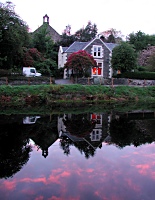 |
||
| Dusk at Crinan Canal |
OK, OK, so it was not so hot with the sun. Quite contrary, for most of our journey in Scotland we drove amidst a depressively enduring rain. Then there was this business with three-day bank holiday, which made us worry about finding a DRY bed that was not already reserved.
That is why we did not hesitate for a minute at Grey Gull Inn of Adrishaig -- our first decent looking VACANT hotel after a row of full ones. It was still a little early for dinner, and a cowardly sun over Loch Fyne looked very ragged and beat up like in the middle of winter. Adrishaig is a tiny town and walking we soon reached its prominent spot, the lighthouse, which seemed to have accounted for all local attractions. But then Sid noticed a strange mechanism by the road -- and that's how we discovered Crinan Canal, which begins at a turning bridge and a sea-lock. We walked along the waterway back to our hotel and wondered what would be the purpose for this canal and whether it was still in operation, as it looked mildly abandoned. It was definitely not big enough to allow passage of larger barges (locks on Vltava in Bohemia are a different thing altogether), and we were not quite sure where such canal would lead to.
In the morning we drove out in a generally northern direction, and chance had it we followed the Crinan Canal. Several small yachts were moving along on it -- and then we spotted a person at a lock, toiling to push a huge swing bar operating the gate. Curious, we stopped and Sid offered to add his Hippo Power at the bar, thus creating an opportunity to chat. Crinan canal was built in years 1793 through 1801 as a safe passage between Adrishaig (Loch Fyne) and Crinan, so that ships would not need to sail around a dangerous Mull of Kintyre. There were only military roads available otherwise in the area at the time of the construction; railroad had not yet arrived to Scottish Highlands, thus the canal represented a very important connection between Oban (a larger town) and Atlantic coast. The canal is 9 miles long, contains 15 locks, a complete journey of one boat through it consumes 65 gallons of water, and the whole trip takes about 8 hours.
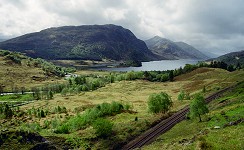 |
||
| Loch Shiel - Glenfinnan Typical Highlands - a landscape which, as surly the weather may look, still remains very photo-attractive. |
Scottish yachtspeople turned out to be very friendly and talkative -- soon we had to remember a long list of recommendations where to go in Scotland, and what places we absolutely must see. Thanks to them, we did not miss a not very well marked Kilmartin Glen, offering menhirs, standing stones and cairns (ancient burial sites), well hidden among green fields of grass and heavily populated by sheep herds.
We were wiggling our way into the Highlands -- lochs got company of serious hills and moors. We liked such landscape
very much and so we endured some hassle with searching for any local lodging. An extended weekend had, of course,
lured most of the nation out into the country, and so we had to be thankful for the last room at Loch Leven Hotel
in a town named North Balachulish, although the owner warned us that this room was "a bit noisy", for it
was over the entrance to a bar. She also mentioned quite proudly that Loch Leven has been for the third year
the site of filming of the most famous Hogwarts (School of Witchcraft and Wizardry). Right - as we later drove
around the lake, we found several spots that looked quite familiar from already released Harry Potter movies.
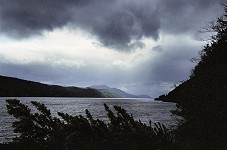 |
||
| Loch Ness was something of a disappointment, as it is surrounded by relatively lower hill, and lots of urban influence. Still this lake has its mysterious moments. |
Evening still far ahead, we took a ferry across Loch Linhe and drove through the Highlands by Loch Sunart and Loch Shiel. Clouds that had pursued us since Hadrian's Wall fell behind and we were, albeit for a short while, enjoying romantic lakes and fjords that reflected snow-capped mountain tops. Highest British mountain (Ben Nevis) can be found here, which is whole thousand feet lower than Sněžka (the highest Czech mountain), yet the grandeur of Scottish Highlands withstands comparison to many world famous mountain ranges. Perhaps it is caused by the fact that these hills rise right from sea level, perhaps weather plays its part with thoughtful fogs and mysterious clouds, or maybe the unusual coloring of the reddish moors catches one's eye -- or there simply IS such strangely beautiful landscape, damned be statistics and measured inches.
This trip of ours made us eventually miss dinner time at our hotel and I was to drive a very disgruntled, hungry Hippo from one closed food place to the next. Deliverance came in the form of a peculiar disco-pizzerio-bar-coffee shop at Ballachulish. Our dreaded night with direct acoustic link to night life at the bar wasn't so bad in the end (for even the most wobbly drunkards are in fact relatively orderly people who head home some time after one a.m.), but that could not be said about a fridge's compressor installed right under our bed. There was not fun in that.
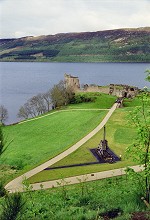 |
||
| And ancient Urquhart Castle on the shore Loch Ness. Swarming crowds of tourist and outrageous entry fee had discouraged us from getting any closer. |
My morning did not open on a friendly note, but once it became apparent that the hotel's owner thought of moving us to another, freed room, we decided to stay another night. For this Sunday, we had planned to hike up on Pap of Glencoe and a (very) variable weather reinforced our belief that we would welcome a warm and dry lodging in the evening. Alas, before we finished our breakfast, weather shifted from variable to steady -- that means endless curtains of rain. We made one heroic attempt to take pictures of nearby waterfalls, but after spending about ten minutes outside of our car we were drenched -- showered from top and brushed by heather from below, treading moor turned into frothing sponge, all that left only limited areas of dry skin, shoulders to waist (whatever fits under goretex). We sadly abandoned our plans for a four-hour ascent where, by my humble estimate, could easily rage a snowstorm. We had to stay in civilization and go looking for the Loch Ness Monster.
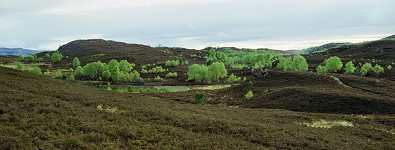 |
||
| Moors near Loch Ness |
I expected the famous Loch Ness (the lake) to be at least as beautiful as "our" Loch Leven was, with some unmistakable air of a strange and horrible mystery of the past lingering around, but I was disappointed. Having driven through Fort William, we effectively left the real Highlands and arrived to an ordinary landscape with forests, sheep -- and fjords. No, it was not ugly nor boring at all, but our previous views had raised the bar pretty high. More or less out of desperation (it was still raining), we visited a Loch Ness Monster museum, and that helped improve our spirits. I can recommend this attraction even for families with children -- audiovisual program consists of short exhibitions, between whose one walks from one setup to the next, which keeps everybody from fidgeting around. Loch Ness is obviously a great tourist magnet -- and it must be a place of many traffic jams and confusion. That's how I understand why right here, you can find several signs saying "Links fahren", "Conduisez a gauche" and "Tenere la sinistra". ("Drive on the left"; we did not find a Czech version, though).
Having driven this far, we chose to make it all the way to Black Isle -- and thus actually cross Scotland
from Atlantic Ocean to North Sea (in its narrowest section). Weather got better with evening
and so we began to regret not staying back in Highlands, were it surely got clearer as well, and where
we would have gone out on our hike. These thoughts resurfaced on our way back, when the setting sun
merrily danced on puddles in moors along our road. Loch Leven awaited us under heavy cloud cover and
a quick survey of locals revealed that sunshine around Loch Ness was a real exception that day.
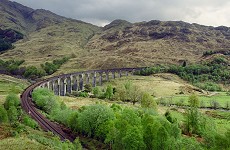 |
||
| Even if you ignore its world-wide movie fame, Glenfinnan still remains a very striking bridge in a breathtaking landscape. |
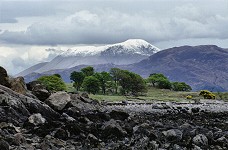 |
||
| Ben Nevis (4,409 feet) Mountains don't reach dizzy heights, but it does not diminish their dignity |
Forecast for Monday said that it would never stop raining in Scotland, while a sunbelt was passing
over England -- and so we checked out of our hotel and began moving back south, with a small detour
to Glenfinnan. Sid claimed that while driving back on Saturday, he spotted something in the fog near
Glenfinnan what looked like a railroad bridge from Harry Potter. You know which one: where Harry and
Ron almost perish in a flying car on collision course with Hogwarts Express. And the bridge was really there
and we even saw a train go over it. True, it was just an ordinary couple of passenger cars, not the
awesome steam engine of the wizard transport.
Quite likely we trespassed on someone's private property when we went uphill to take proper pictures,
which we later (successfully) compared with our DVD. The bridge is really beautiful, a long turn
in a typical valley opening into a fjord. We were in for yet another encounter: on a slope next to
the tracks, a group of wild elks was resting. Britain is quite heavily populated, and originally
"deserted" areas became civilized, game has been hunted for centuries, and almost systematically
decimated. I believe an ordinary elk is actually a rare sight.
Finally we stopped for our last Scottish picnic with a view to Britain's highest mountain Ben Nevis (4,409 feet or 1,344 meters) and soon we re-entered a land where we at least had some idea how to pronounce local town names.
| Copyright © 2003-2005 by Carol & Sid Paral. All rights reserved. |